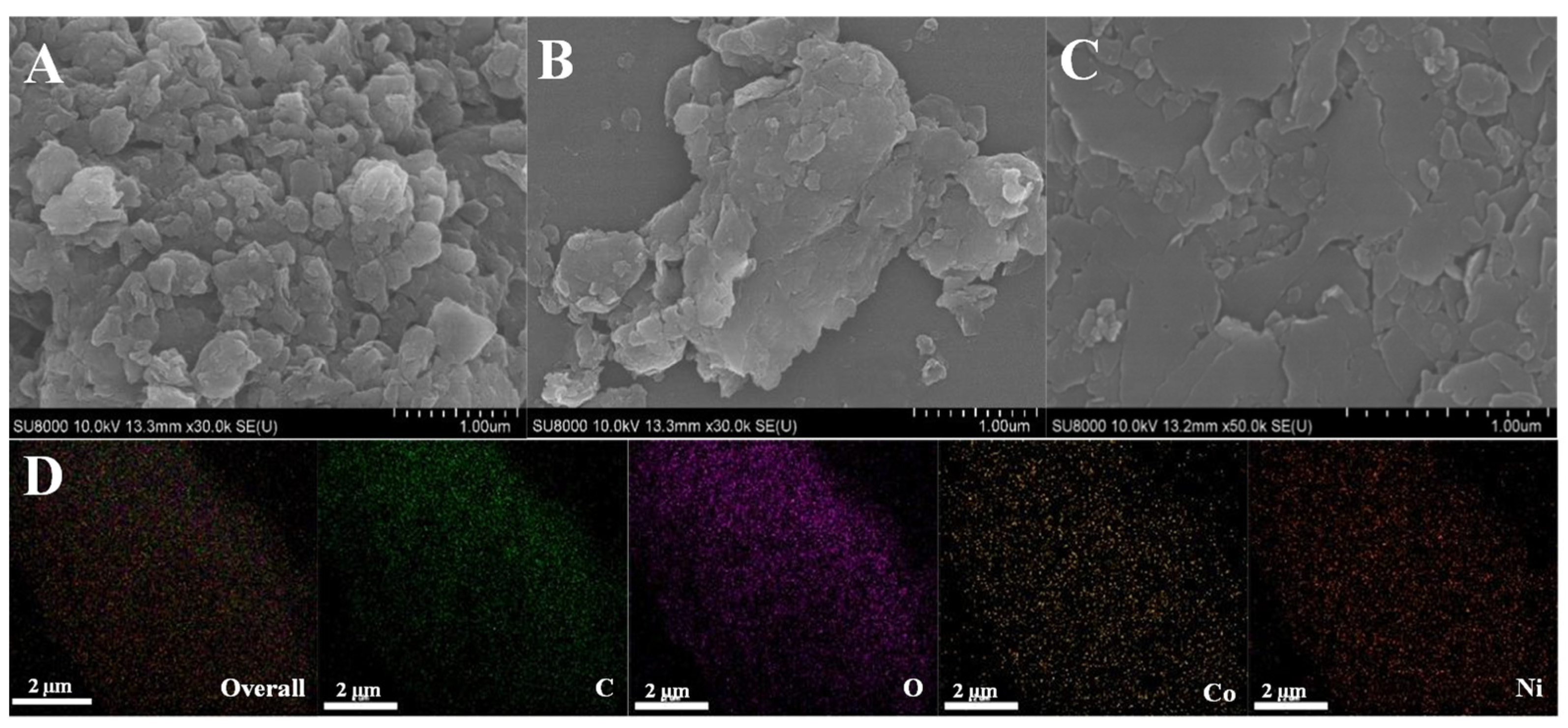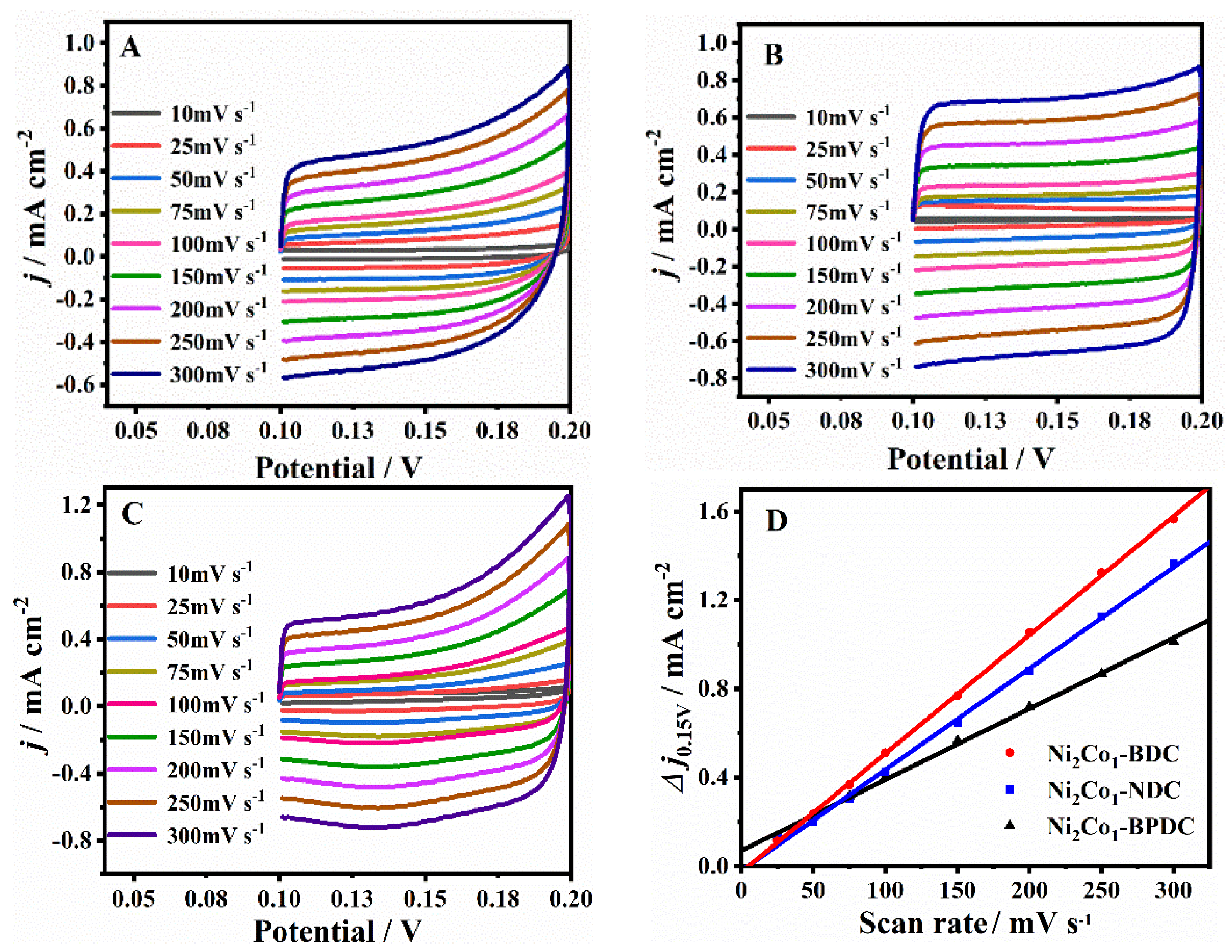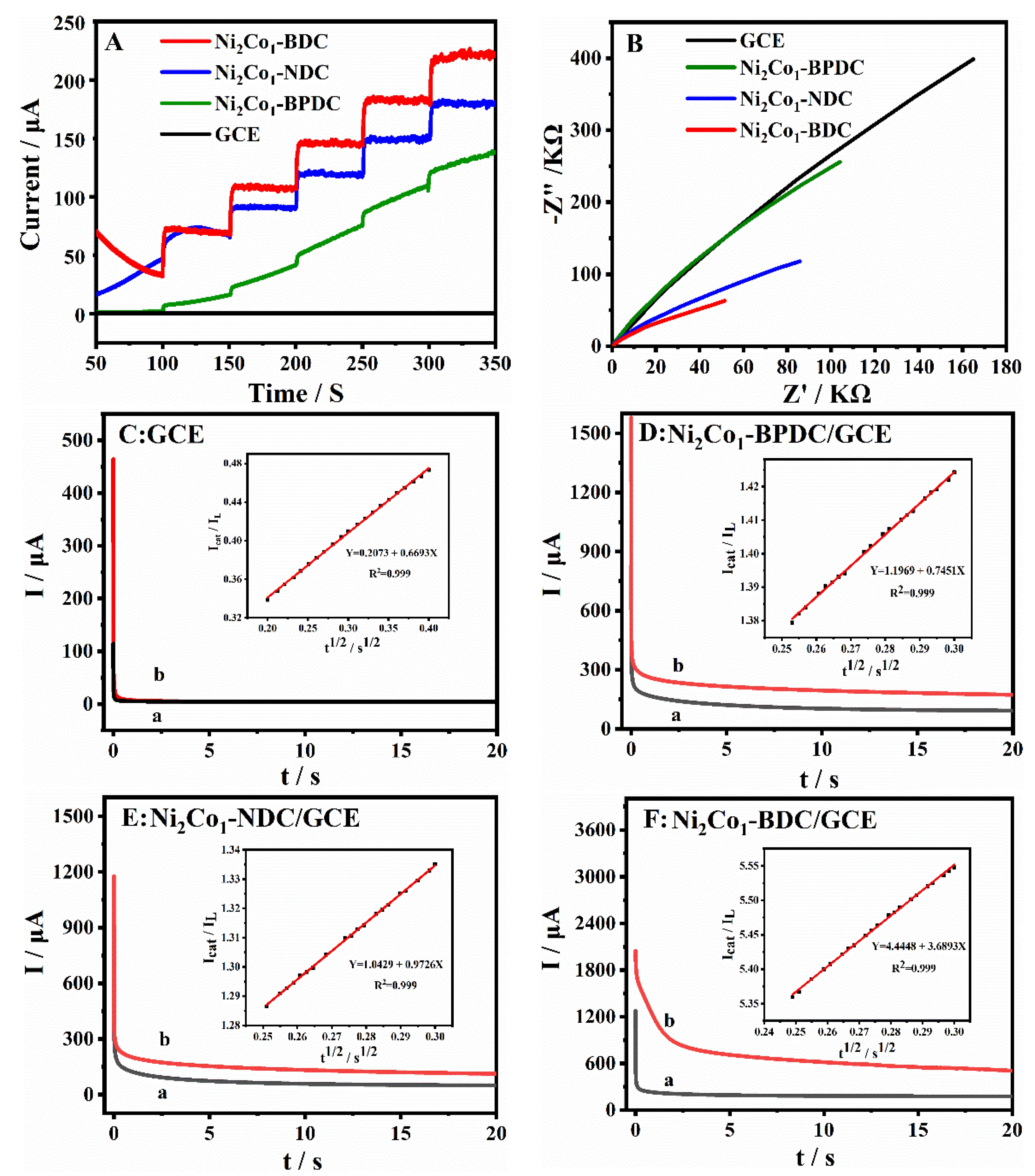Tunable Non-Enzymatic Glucose Electrochemical Sensing Based on the Ni/Co Bimetallic MOFs
Abstract
:1. Introduction
2. Results and Discussion
2.1. Characterization of Ni2Co1-L MOFs
2.2. Electrochemical Performance of Ni2Co1-L MOFs
2.3. Electrochemical Oxidation of Glucose on Ni2Co1-L/GCEs
2.4. Non-Enzymatic Glucose Sensing Based on the Ni2Co1-BDC/GCE
| Modified Electrode | Linear Range (µM) | LOD (µM) | Sensitivity (µA mM−1cm−2) | Ref. |
|---|---|---|---|---|
| Ni/ZAC-O NTAs | 0–2800 | 1.02 | 1553 | [48] |
| NiCo-hmf | 1000–10,000 | 0.31 | 1739.04 | [49] |
| NiO nanofiber/GO | 2–600 | 0.8 | 1100 | [50] |
| Mn3O4/N-doped rGO | 2.5–529.5 | 1 | 1423.9 | [51] |
| Ni@Cu-MOF | 5–2500 | 1.67 | 1703.33 | [52] |
| Ni2Co1-BDC/GCE | 0.5–2899.5 | 0.29 | 3925.3 | This work |
3. Materials and Methods
3.1. Reagents and Solutions
3.2. Instruments
3.3. Synthesis of Ni2Co1-L MOFs
3.4. Preparation of the Ni2Co1-L MOFs Modified GCE
4. Conclusions
Supplementary Materials
Author Contributions
Funding
Institutional Review Board Statement
Informed Consent Statement
Data Availability Statement
Conflicts of Interest
Sample Availability
References
- Beckles, G.L.; Bullard, K.M.K.; Saydah, S.; Imperatore, G.; Loustalot, F.; Correa, A. Life course socioeconomic position, allostatic load, and incidence of Type 2 diabetes among African American Adults: The Jackson Heart Study, 2000-04 to 2012. Ethnic. Dis. 2019, 29, 39. [Google Scholar] [CrossRef] [PubMed] [Green Version]
- Liu, Y.A.; Chen, Q.Q.; Li, Y.Q.; Bi, L.L.; He, Z.Y.; Shao, C.X.; Jin, L.B.; Peng, R.Y.; Zhang, X.X. Advances in FGFs for diabetes care applications. Life Sci. 2022, 310, 121015. [Google Scholar] [CrossRef] [PubMed]
- Jiao, Y.F.; Li, J.; Xiang, J.Y.; Chen, Z.B. Tungsten disulfide nanosheets-based colorimetric assay for glucose sensing. Spectrochim. Acta Part A 2020, 242, 118706. [Google Scholar] [CrossRef] [PubMed]
- Sawayama, J.; Okitsu, T.; Nakamata, A.; Takeuchi, S.; Kawahara, Y. Hydrogel glucose sensor with in vivo stable fluorescence intensity relying on antioxidant enzymes for continuous glucose monitoring. iScience 2020, 23, 101243. [Google Scholar] [CrossRef]
- Yang, S.Y.; Wang, Y.H.; Sheng, Q.L. Heterostructural NiCo2O4 nanocomposites for nonenzymatic electrochemical glucose sensing. Electroanalysis 2022, 34, 835–843. [Google Scholar] [CrossRef]
- Chen, C.; Ran, R.; Yang, Z.Y.; Lv, R.T.; Shen, W.C.; Kang, F.Y.; Huang, Z.H. An efficient flexible electrochemical glucose sensor based on carbon nanotubes/carbonized silk fabrics decorated with Pt microspheres. Sens. Actuator B Chem. 2018, 256, 63–70. [Google Scholar] [CrossRef]
- Mao, W.W.; Cai, B.; Ye, Z.Z.; Huang, J.Y. A nanostructured p-NiO/n-Bi4Ti3O12 heterojunction for direct GOx electrochemistry and high-sensitivity glucose sensing. Sens. Actuator B Chem. 2018, 261, 385–391. [Google Scholar] [CrossRef]
- Song, Y.; Zhu, C.Z.; Li, H.; Du, D.; Lin, Y.H. A nonenzymatic electrochemical glucose sensor based on mesoporous Au/Pt nanodendrites. RSC Adv. 2015, 5, 82617–82622. [Google Scholar] [CrossRef]
- Huang, B.B.; Wang, Y.; Lu, Z.W.; Ye, J.S.; Du, H.J. One pot synthesis of palladium-cobalt nanoparticles over carbon nanotubes as a sensitive non-enzymatic sensor for glucose and hydrogen peroxide detection. Sens. Actuator B Chem. 2017, 252, 1016–1025. [Google Scholar] [CrossRef]
- Niu, X.H.; Lan, M.B.; Chen, C.; Zhao, H.L. Nonenzymatic electrochemical glucose sensor based on novel Pt-Pd nanoflakes. Talanta 2012, 99, 1062–1067. [Google Scholar] [CrossRef]
- Muqaddas, S.; Aslam, H.; Hassan, S.U.; Ashraf, A.R.; Asghar, M.A.; Ahmad, M.; Nazir, A.; Shoukat, R.; Kaleli, M.; Ibrahim, S.M.; et al. Electrochemical sensing of glucose and ascorbic acid via POM-based CNTs fiber electrode. Mater. Sci. Eng. B-Adv. 2023, 293, 116446. [Google Scholar] [CrossRef]
- Chou, J.C.; Lin, S.H.; Lai, T.Y.; Kuo, P.Y.; Lai, C.H.; Nien, Y.H.; Su, T.Y. A facile fabrication of a potentiometric arrayed glucose biosensor based on nafion-GOx/GO/AZO. Sensors 2020, 20, 964. [Google Scholar] [CrossRef] [Green Version]
- Juang, F.R.; Wang, T.M. Synthesis of Self-Assembled CuO Sphere Structures and Their Glucose Sensing Characteristics. J. Electrochem. Soc. 2021, 168, 037508. [Google Scholar] [CrossRef]
- Guo, S.X.; Zhang, C.H.; Yang, M.; Wang, L.; Li, R.Q.; Ma, N. Three-dimensional flexible polyurethane decorated with Ni and reduced graphene oxide for high-sensitive sensing of glucose. Mater. Chem. Phys. 2022, 278, 125679. [Google Scholar] [CrossRef]
- Xiong, C.; Tian, L.; Xiao, C.C.; Xue, Z.G.; Zhou, F.Y.; Zhou, H.; Zhao, Y.F.; Chen, M.; Wang, Q.P.; Qu, Y.T.; et al. Construction of highly accessible single Co site catalyst for glucose detection. Sci. Bull. 2020, 65, 2100–2106. [Google Scholar] [CrossRef] [PubMed]
- Dai, X.L.; Deng, W.Q.; You, C.; Shen, Z.; Xiong, X.L.; Sun, X.P. A Ni3N-Co3N hybrid nanowire array electrode for high-performance nonenzymatic glucose detection. Anal. Methods 2018, 10, 1680–1684. [Google Scholar] [CrossRef]
- Chen, T.; Liu, D.N.; Lu, W.B.; Wang, K.Y.; Du, G.; Asiri, A.M.; Sun, X.P. Three-dimensional Ni2P nanoarray: An efficient catalyst electrode for sensitive and selective nonenzymatic glucose sensing with high specificity. Anal. Chem. 2016, 88, 7885–7889. [Google Scholar] [CrossRef] [Green Version]
- Wang, F.; Zhao, D.S.; Li, W.Q.; Zhang, H.H.; Li, B.; Hu, T.P.; Fan, L.M. Rod-shaped unitsbased cobalt (II) organic framework as an efficient electrochemical sensor for uric acid detection in serum. Microchem. J. 2023, 185, 108154. [Google Scholar] [CrossRef]
- Ma, L.; Svec, F.; Lv, Y.Q.; Tan, T.W. Engineering of the filler/polymer interface in metal-organic framework-based mixed-matrix membranes to enhance gas separation. Chem-Asian J. 2019, 14, 3502–3514. [Google Scholar] [CrossRef] [PubMed]
- Mullangi, D.; Evans, H.A.; Yildirim, T.; Wang, Y.X.; Deng, Z.Y.; Zhang, Z.Q.; Mai, T.T.; Wei, F.X.; Wang, J.; Walker, A.R.H.; et al. Noncryogenic Air Separation Using Aluminum Formate Al(HCOO)3 (ALF). J. Am. Chem. Soc. 2023, 145, 9850–9856. [Google Scholar] [CrossRef]
- Xiao, P.T.; Xu, Y.X. Recent progress in two-dimensional polymers for energy storage and conversion: Design, synthesis, and applications. J. Mater. Chem. A 2018, 6, 21676–21695. [Google Scholar] [CrossRef]
- Souri, Z.; Mazloum-Ardakani, M.; Alizadeh, S.; Nematollahi, D. Template-free electrodeposition of sponge-like porous polymer interwoven with the bimetallic metal-organic framework and reduced graphene oxide and application in energy storage device. J. Energy Storage 2022, 55, 105381. [Google Scholar] [CrossRef]
- Zhang, Z.Q.; Deng, Z.Y.; Evans, H.A.; Mullangi, D.; Kang, C.J.; Peh, S.B.; Wang, Y.X.; Brown, C.M.; Wang, J.; Canepa, P.; et al. Exclusive Recognition of CO2 from Hydrocarbons by Aluminum Formate with Hydrogen-Confined Pore Cavities. J. Am. Chem. Soc. 2023, 145, 11643–11649. [Google Scholar] [CrossRef] [PubMed]
- Li, W.Q.; Zhao, D.S.; Li, W.C.; Wen, R.M.; Liu, X.; Liu, L.Y.; Li, T.; Fan, L.M. Chemorobust dye-encapsulated framework as dual-emission self-calibrating ratiometric sensor for intelligent detection of toluene exposure biomarker in urine. Spectrochim. Acta Part A 2023, 296, 122637. [Google Scholar] [CrossRef]
- Zhao, K.M.; Zhu, W.W.; Liu, S.Q.; Wei, X.L.; Ye, G.Y.; Su, Y.K.; He, Z. Two-dimensional metal-organic frameworks and their derivatives for electrochemical energy storage and electrocatalysis. Nanoscale Adv. 2020, 2, 536–562. [Google Scholar] [CrossRef] [PubMed]
- Zhao, D.S.; Li, W.Q.; Wen, R.M.; Li, W.C.; Liu, X.; Zhang, X.T.; Fan, L.M. Tb (III) functionalized MOF based self-calibrating sensor integrated with logic gate operation for efficient epinephrine detection in serum. J. Rare Earths 2023. [Google Scholar] [CrossRef]
- Han, Y.; Liu, Z.J.; Zheng, F.F.; Bai, Y.X.; Zhang, Z.Q.; Li, X.G.; Xiong, W.W.; Zhang, J.H.; Yuan, A.H. Two-dimensional flower-like cobalt-porphyrin MOF/rGO composite anodes for high-performance Li-ion batteries. J. Alloys. Compd. 2021, 881, 160531. [Google Scholar] [CrossRef]
- Ji, L.D.; Wang, Q.; Peng, L.H.; Li, X.Y.; Zhu, X.M.; Hu, P. Cu-TCPP Nanosheets-Sensitized Electrode for Simultaneous Determination of Hydroquinone and Catechol. Materials 2022, 15, 4625. [Google Scholar] [CrossRef]
- Han, L.J.; Zheng, D.; Zheng, H.G.; Ma, J.; Chen, S.G. A Highly Solvent-Stable Metal-Organic Framework Nanosheet: Morphology Control, Exfoliation, and Luminescent Property. Small 2018, 14, 1703873. [Google Scholar] [CrossRef]
- Chen, L.Y.; Wang, H.F.; Li, C.X.; Xu, Q. Bimetallic metal-organic frameworks and their derivatives. Chem. Sci. 2020, 11, 5369–5403. [Google Scholar] [CrossRef]
- Niu, S.Y.; Li, C.H.; Huo, J.; Dong, W.R.; Hankari, S.E.; Liang, Y.; Li, Q.L. Ultrathin Trimetal-Organic Framework Nanosheet Electrocatalysts for the Highly Efficient Oxygen Evolution Reaction. ACS Omega 2021, 6, 13946–13952. [Google Scholar] [CrossRef] [PubMed]
- Mullangi, D.; Dhavale, V.; Shalini, S.; Nandi, S.; Collins, S.; Woo, T.; Kurungot, S.; Vaidhyanathan, R. Low-Overpotential Electrocatalytic Water Splitting with Noble-Metal-Free Nanoparticles Supported in a sp3 N-Rich Flexible COF. Adv. Energy Mater. 2016, 6, 1600110. [Google Scholar] [CrossRef]
- Nandi, S.; Singh, S.K.; Mullangi, D.; Illathvalappil, R.; George, L.; Vinod, C.P.; Kurungot, S.; Vaidhyanathan, R. Low band gap benzimidazole COF supported Ni3N as highly active OER catalyst. Adv. Energy Mater. 2016, 6, 1601189. [Google Scholar] [CrossRef]
- Pan, L.; Ching, N.; Huang, X.Y.; Li, J. Reactions and Reactivity of Co-bpdc Coordination Polymers (bpdc = 4,4‘-biphenyldicarboxylate). Inorg. Chem. 2000, 39, 5333–5340. [Google Scholar] [CrossRef]
- Carton, A.; Mesbah, A.; Mazet, T.; Porcher, F.; François, M. Ab initio crystal structure of nickel (II) hydroxy-terephthalate by synchrotron powder diffraction and magnetic study. Solid State Sci. 2007, 9, 465–471. [Google Scholar] [CrossRef]
- Du, Y.; Thompson, A.L.; O’Hare, D. Resin-assisted solvothermal synthesis of metal-organic frameworks. Chem. Commun. 2008, 45, 5987–5989. [Google Scholar] [CrossRef] [Green Version]
- Inoue, S.; Fujihara, S. Liquid-Liquid biphasic synthesis of layered zinc hydroxides intercalated with long-chain carboxylate ions and their conversion into ZnO nanostructures. Inorg. Chem. 2011, 50, 3605–3612. [Google Scholar] [CrossRef]
- Rawool, C.R.; Karna, S.P.; Srivastava, A.K. Enhancing the supercapacitive performance of Nickel based metal organic framework-carbon nanofibers composite by changing the ligands. Electrochimica. Acta 2019, 294, 345–356. [Google Scholar] [CrossRef]
- Ahsan, M.A.; Jabbari, V.; Imam, M.A.; Castro, E.; Kim, H.; Curry, M.L.; Valles-Rosales, D.J.; Noveron, J.C. Nanoscale nickel metal organic framework decorated over graphene oxide and carbon nanotubes for water remediation. Sci. Total Environ. 2020, 698, 134214. [Google Scholar] [CrossRef]
- Cavka, J.H.; Jakobsen, S.; Olsbye, U.; Guillou, N.; Lamberti, C.; Bordiga, S.; Lillerud, K.P. A new zirconium inorganic building brick forming metal organic frameworks with exceptional stability. J. Am. Chem. Soc. 2008, 130, 13850–13851. [Google Scholar] [CrossRef]
- Ji, L.D.; Li, F.; Li, C.L.; Hu, P. Solvent-exfoliated Cu-TCPP nanosheets: Electrochemistry and sensing application in simultaneous determination of 4-aminophenol and acetaminophen. Microchem J. 2022, 181, 107688. [Google Scholar] [CrossRef]
- Gumilar, G.; Kaneti, Y.V.; Henzie, J.; Chatterjee, S.; Na, J.; Yuliarto, B.; Nugraha, N.; Patah, A.; Bhaumik, A.; Yamauchi, Y. General synthesis of hierarchical sheet/plate-like M-BDC (M= Cu, Mn, Ni, and Zr) metal-organic frameworks for electrochemical non-enzymatic glucose sensing. Chem. Sci. 2020, 11, 3644–3655. [Google Scholar] [CrossRef] [PubMed] [Green Version]
- Katz, E.; Willner, I. Probing biomolecular interactions at conductive and semiconductive surfaces by impedance spectroscopy: Routes to impedimetric immunosensors, DNA-sensors, and enzyme biosensors. Electroanalysis 2003, 15, 913–947. [Google Scholar] [CrossRef]
- Dong, Y.Y.; Zhou, M.; Zhang, L. 3D multiporous Co, N co-doped MoO2/MoC nanorods hybrids as improved electrode materials for highly sensitive simultaneous determination of acetaminophen and 4-aminophenol. Electrochim. Acta 2019, 302, 56–64. [Google Scholar] [CrossRef]
- Rezaeinasab, M.; Benvidi, A.; Tezerjani, M.D.; Jahanbani, S.; Kianfar, A.H.; Sedighipoor, M. An electrochemical sensor based on Ni (II) complex and multi wall carbon nano tubes platform for determination of glucose in real samples. Electroanalysis 2017, 29, 423–432. [Google Scholar] [CrossRef]
- Wu, G.H.; Song, X.H.; Wu, Y.F.; Chen, X.M.; Luo, F.; Chen, X. Non-enzymatic electrochemical glucose sensor based on platinum nanoflowers supported on graphene oxide. Talanta 2013, 105, 379–385. [Google Scholar] [CrossRef]
- Wei, Z.Y.; Zhu, W.X.; Li, Y.; Ma, Y.Y.; Wang, J.; Hu, N.; Suo, Y.R.; Wang, J.L. Conductive leaflike cobalt metal-organic framework nanoarray on carbon cloth as a flexible and versatile anode toward both electrocatalytic glucose and water oxidation. Inorg. Chem. 2018, 57, 8422–8428. [Google Scholar] [CrossRef]
- Wu, X.; Chen, F.; Huang, M.; Dan, Z.; Qin, F. Ni-decorated ZrAlCo-O nanotube arrays with ultrahigh sensitivity for non-enzymatic glucose sensing. Electrochim. Acta 2019, 311, 201–210. [Google Scholar] [CrossRef]
- He, L.; Cao, J.; Li, J.W.; Li, X.; Fan, P.P.; Yang, Y. Highly efficient non-enzymatic glucose biosensor based on Ni0.5Co0.5(OH)2 microflowers adorned glassy carbon electrode. Mater. Lett. 2021, 301, 130197. [Google Scholar] [CrossRef]
- Zhang, Y.Q.; Wang, Y.Z.; Jia, J.B.; Wang, J.G. Nonenzymatic glucose sensor based on graphene oxide and electrospun NiO nanofibers. Sens. Actuator B-Chem. 2012, 171, 580–587. [Google Scholar] [CrossRef]
- Yang, S.L.; Li, G.; Wang, G.F.; Zhao, J.H.; Gao, X.H.; Qu, L.B. Synthesis of Mn3O4 nanoparticles/nitrogen-doped graphene hybrid composite for nonenzymatic glucose sensor. Sens. Actuator B-Chem. 2015, 221, 172–178. [Google Scholar] [CrossRef]
- Xue, Z.; Jia, L.; Zhu, R.R.; Du, L.; Zhao, Q.H. High-performance non-enzymatic glucose electrochemical sensor constructed by transition nickel modified Ni@ Cu-MOF. J. Electroanal. Chem. 2020, 858, 113783. [Google Scholar] [CrossRef]







| No. | by Glucometer (mM) | Ni2Co1-BDC/GCE (mM) | Relative Error |
|---|---|---|---|
| 1 | 5.61 | 5.70 | 1.6% |
| 2 | 6.04 | 6.05 | 0.2% |
| 3 | 5.76 | 5.56 | −3.5% |
| 4 | 4.95 | 4.92 | −0.61% |
Disclaimer/Publisher’s Note: The statements, opinions and data contained in all publications are solely those of the individual author(s) and contributor(s) and not of MDPI and/or the editor(s). MDPI and/or the editor(s) disclaim responsibility for any injury to people or property resulting from any ideas, methods, instructions or products referred to in the content. |
© 2023 by the authors. Licensee MDPI, Basel, Switzerland. This article is an open access article distributed under the terms and conditions of the Creative Commons Attribution (CC BY) license (https://creativecommons.org/licenses/by/4.0/).
Share and Cite
Wang, Q.; Jia, Q.; Hu, P.; Ji, L. Tunable Non-Enzymatic Glucose Electrochemical Sensing Based on the Ni/Co Bimetallic MOFs. Molecules 2023, 28, 5649. https://doi.org/10.3390/molecules28155649
Wang Q, Jia Q, Hu P, Ji L. Tunable Non-Enzymatic Glucose Electrochemical Sensing Based on the Ni/Co Bimetallic MOFs. Molecules. 2023; 28(15):5649. https://doi.org/10.3390/molecules28155649
Chicago/Turabian StyleWang, Qi, Qi Jia, Peng Hu, and Liudi Ji. 2023. "Tunable Non-Enzymatic Glucose Electrochemical Sensing Based on the Ni/Co Bimetallic MOFs" Molecules 28, no. 15: 5649. https://doi.org/10.3390/molecules28155649
APA StyleWang, Q., Jia, Q., Hu, P., & Ji, L. (2023). Tunable Non-Enzymatic Glucose Electrochemical Sensing Based on the Ni/Co Bimetallic MOFs. Molecules, 28(15), 5649. https://doi.org/10.3390/molecules28155649






